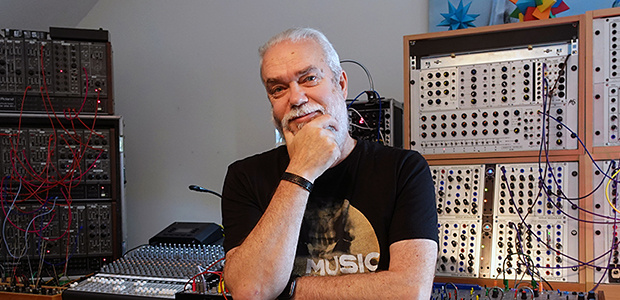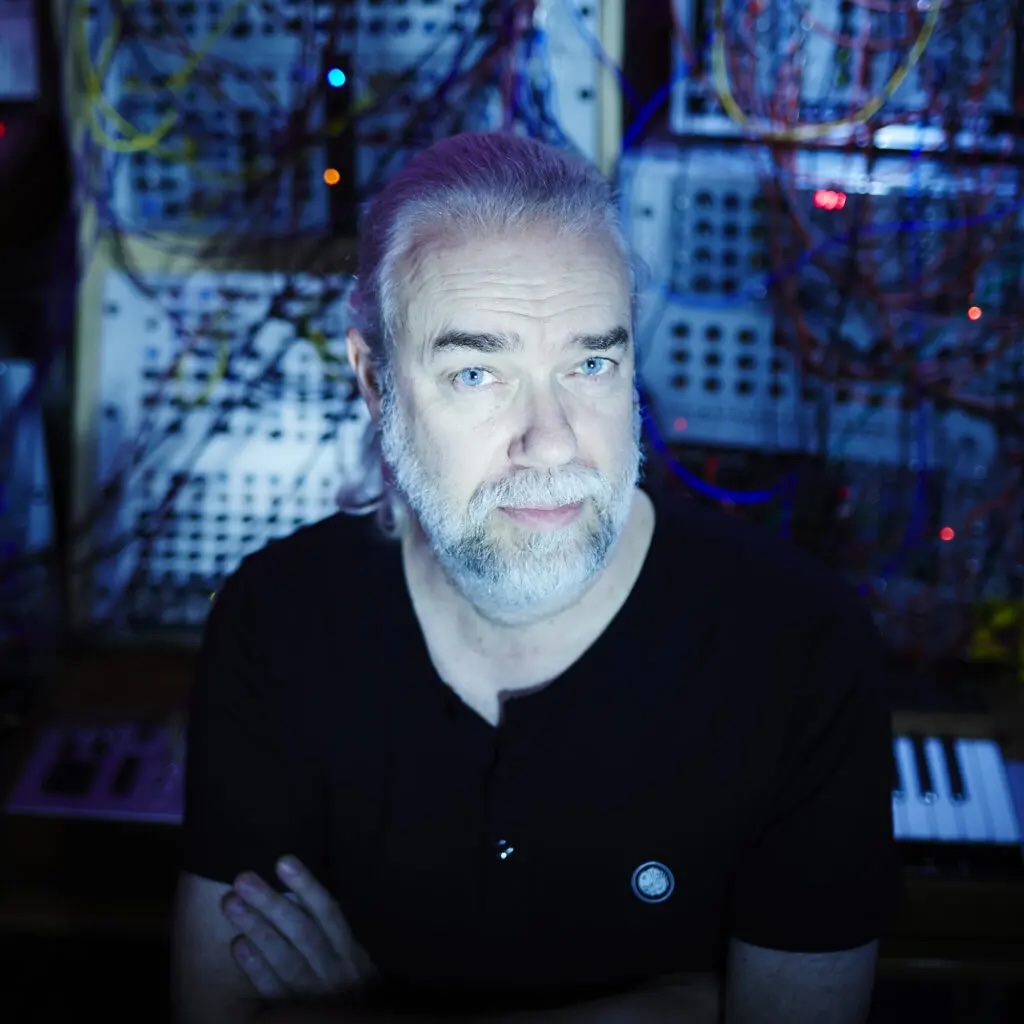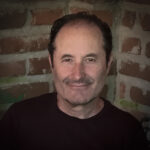Ian Boddy
«Music has so many permutations and avenues to explore»

Ian Boddy es un reconocido compositor y diseñador sonoro, oriundo de Newcastle upon Tyne, Inglaterra, activo desde finales de los ’70. En los ‘80 lanzó varios trabajos de ambient y new age en distintos sellos que comprenden una discografía de más de 50 discos, posicionándose a la vanguardia de la síntesis analógica y reuniendo a través de los años, una gran variedad de equipos electrónicos, por lo que se declara un aficionado del sintetizador análogo.
En 1999, fundó el sello DiN que ha lanzado música de Robert Rich, Centrozoon, Mark Shreeve, entre otros.
El más reciente disco de Ian Boddy, “Modal Operandi” se integra a la serie del sello británico Quiet Details que incluye un interesante cartel de artistas que son referente de la música ambient actual como Arovane, Maps and Diagram, Observatories y desde luego, nuestro protagonista.
Boddy tiene tres actividades musicales principales que se desarrollan bajo el paraguas de su propia empresa, Something Else Music Limited: El sello de ambient electrónico DiN; la composición de una biblioteca musical y el diseño sonoro.
En este nuevo álbum, el músico británico usa tanto una variedad de sintetizadores y efectos clásicos, como sintetizadores modulares avanzados, desplegando así pads melancólicos envolventes, reverbs y delays expansivos, creando así inquietantes atmósferas y melodías edificantes, junto a arpeggios cósmicos.
Agradecemos a Alex de Quiet Details por gestionar esta entrevista y a Ian Boddy por contarnos acerca de su visión de su música y la actual.
Cuándo te interesaste en producir tu propia música y qué artistas/bandas fueron tus referentes?
“En mi adolescencia me gustaba más hacer arte que música. No tenía formación musical formal, así que ni siquiera era algo que había considerado. De hecho, cuando fui a la universidad estudié Bioquímica. Sin embargo, quería seguir haciendo mi arte. En mi tiempo libre me hablaron de este complejo de estudios de acceso abierto llamado Spectro Arts Workshop, donde podía hacer serigrafía. Mis gustos musicales en ese momento eran bandas progresivas como Camel y Focus y músicos electrónicos alemanes como Tangerine Dream, Klaus Schulze, Ash (Ra Tempel), etc. Entonces alguien me dijo que arriba en Spectro tenían un estudio de sonido con algunos de los equipos que usaban estos artistas electrónicos, así que subí, abrí la puerta y me encontré con VCS3, grabadoras Revox, etc. Me enganché. Al poco tiempo estaba experimentando con el sonido y rápidamente dejé la serigrafía para concentrar mis esfuerzos artísticos en la música. ¡Nunca he parado desde entonces!”
Dado que la música electrónica se remonta a los años 40, ¿cómo era hacer música electrónica en los años 70, considerando que los artistas/bandas de rock estaban de moda?
“Bueno, para empezar, nunca he considerado lo que estaba «de moda». Siempre seguí mi propio camino e hice la música que quería hacer. El año en que comencé a experimentar en Spectro fue 1978, así que esto era pre-MIDI y computadoras domésticas. Utilicé muchas técnicas de cinta como ecos, loops y sistemas de largo retardo. Estas técnicas analógicas y prácticas son una muy buena base para saber cómo manipular el sonido. Por supuesto, en ese tiempo la música electrónica de la que estamos hablando aquí, estaba fuertemente influenciada por los artistas alemanes que mencioné, así como por músicos como Vangelis y Jean Michel Jarre, ciertamente no era una corriente convencional. De hecho, en el Reino Unido probablemente solo había un puñado de músicos siguiendo este camino y fue el sello de cintas Mirage, el que presentó al público a muchos de estos músicos, como yo y mi tristemente fallecido amigo Mark Shreeve».
Con el arsenal de equipos electrónicos que has acumulado a lo largo de tu carrera, imagino que todavía hay muchos sonidos nuevos por explorar. ¿Qué piensas de esto?
“Si se me permite, voy a utilizar una cita mía que apareció tiempo atrás y que es: ‘A mí personalmente me encanta el sonido: el sonido puro en todas sus formas. La música tiene tantas permutaciones y caminos para explorar que es imposible verlo todo en una sola vida. Así que tienes que emprender un viaje personal que te lleve por caminos y pistas que sean únicas para ti’.
Esto es lo que lo mantiene fresco y emocionante. Nunca te quedarás sin cosas por explorar mientras mantengas la mente abierta y estés dispuesto a tomar algunos riesgos musicales”.
¿Cuál es tu opinión sobre la música electrónica de hoy en día?
«No estoy seguro de tener una opinión per se. Quiero decir, el término ‘música electrónica’ ahora cubre una gama tan amplia de subgéneros, entre los que se encuentran todos los diversos estilos de baile que simplemente no existían cuando estaba empezando. Sin duda, una de las tendencias más bienvenidas ha sido la explosión de sistemas modulares compactos y fácilmente asequibles que ha visto a muchos más artistas salir del estudio y actuar en público. Me encanta la energía y la emoción de estas actuaciones y es genial involucrar a más gente en la música electrónica de esta manera».
¿Cuáles son los lugares/sitios específicos donde te interesa capturar grabaciones de campo?
“Bueno, en cualquier lugar eso suena interesante. Y, por supuesto, nunca se sabe dónde estará. Por ejemplo, en unas vacaciones recientes en Peak District, en el Reino Unido, me encontré con un antiguo túnel ferroviario por el que se podía caminar y que pasaba por debajo de una ciudad. Tenía más de 300 metros de largo, así que te puedes imaginar la reverberación increíble que tenía. Sin embargo, cuando estuve allí, también había un grupo de niños de la escuela en una excursión. Estaban todos emocionados, gritando y chillando. Al principio pensé qué pena, No puedo grabar nada, pero entonces pensé: ¿por qué no? Así que caminé lentamente por el túnel alejándome de ellos grabando en mi Tascam portátil. Al escuchar esta grabación en el estudio, decidí ejecutarla a media velocidad y en reversa, recordando lo que dije anteriormente sobre aprender de mis técnicas de cinta en Spectro. De repente tuvimos una atmósfera realmente extraña e inquietante que usé como parte de la canción ‘Mixolydian’ en el álbum ‘Modal Operandi’”.
Tienes una interesante lista de artistas en tu sello DiN como Benge, Field Lines Cartographer, Scanner. ¿Qué te gustaría destacar de tu sello? ¿Qué pasa con el subsello Tone Science de DiN?
«Lo más importante en estos momentos es que DiN celebrará su 25º aniversario esta primavera. Me parece sorprendente que el pequeño sello independiente que creé en 1999 tenga un cuarto de siglo. Ha sido un placer increíble y es un privilegio haber trabajado con tantos excelentes músicos a lo largo de los años. Cualquier otra cosa que haga a partir de este momento, sin duda será un gran momento para mí. Como dijiste, hay una gran lista de artistas en DiN y el mejor lugar para explorar es Bandcamp. Para cualquiera que no esté seguro por dónde empezar, pruebe las compilaciones digitales ‘DiN MiX’ o la serie de muestras ‘iNDEX’; muchas de ellas se pueden descargar gratis (ponga su precio)”.
¿Puedes contarnos acerca de tus próximos proyectos?
«Como parte de las celebraciones del 25º aniversario, tengo un bello concierto con el guitarrista ambiental noruego Erik Wøllo que se celebrará en Liverpool a finales de abril. También estoy preparando un lanzamiento en CD bastante especial con la mayoría de los artistas del cartel principal del sello DiN”.

Ian Boddy is a renowned composer and sound designer, originally from Newcastle upon Tyne, England, active since the late ’70s. In the ’80s he released several ambient and new age works on different labels that comprise a discography of over 50 albums, positioning himself at the forefront of analog synthesis and gathering, over the years, an array of electronic equipment, which is why he declares himself a fan of the analog synthesizer.
In 1999, he founded the DiN label which has released music by Robert Rich, Centrozoon, Mark Shreeve, among other artists.
Ian Boddy’s latest album, “Modal Operandi” is part of the series by the British label Quiet Details that includes an interesting roster who are a reference for current ambient music such as Arovane, Maps and Diagram, Observatories and of course, our protagonist.
Boddy has three main musical activities that run under the umbrella of his own company, Something Else Music Limited: Electronic ambient label DiN; the composition of a music library and sound design.
On this new album, the British musician uses both a variety of classic synthesizers and effects, as well as advanced modular synthesizers, deploying enveloping melancholic pads, reverbs, and expansive delays, creating haunting atmospheres and uplifting melodies, alongside cosmic arpeggios.
We thank Alex from Quiet Details for arranging this interview and to Ian Boddy for sharing his vision about his music and music nowadays.
Please tell us when you became interested in producing your own music and what artists/bands were your references?
«In my teens I was more into making art than music. I had no formal musical training, so it wasn’t even something that I had considered. In fact, when I went to University I studied Biochemistry. However, I wanted to still do my art in my spare time so I was told about this open access studio complex called Spectro Arts Workshop where I could do screen printing. My musical tastes at this time were prog bands such as Camel and Focus as well as the German electronic musicians such as Tangerine Dream, Klaus Schulze, Ash (Ra Tempel) etc. Then someone told me that upstairs in Spectro they had a sound studio with some of the gear these electronic artists used – so up I went, opened the door to be confronted with VCS3’s, Revox tape recorders etc. I was hooked. Before long I was experimenting with sound and quickly gave up my screen printing to concentrate my artistic endeavours into music. I’ve never stopped since!»
Regarding that electronic music was created dates to the ’40s, how it was to make electronic music in the ’70s, considering that rock artists/bands were in vogue?
«Well for one thing I’ve never considered what was “in vogue”. I’ve always followed my own path and did the music I wanted to do. The year I started experimenting at Spectro was 1978 so this was pre-MIDI and home computers. I used a lot of tape techniques such as echo, loops and long delay systems. These hands on, analogue techniques are a very good grounding in knowing how to manipulate sound. Of course at that time the electronic music we’re talking about here, heavily influenced by those German artists I mentioned as well as musicians such as Vangelis & Jean Michel Jarre, was certainly not mainstream. In fact, in the UK there was probably only a handful of musicians heading down this route and it was a tape label called Mirage who introduced a lot of these musicians to the public such as myself and my sadly departed friend Mark Shreeve.»
With the arsenal of electronic gear you’ve amassed across your career, I imagine there are still plenty of new sounds to explore. What do you think about this?
«If I may I’m going to use a quote of mine that has appeared before which is: ‘For me personally I just love sound – pure sound in all its shapes and forms. Music has so many permutations and avenues to explore that it is impossible in any single lifetime to see it all. So you have to go on a personal journey that takes you down paths and tracks that are unique to you.’
This is what keeps it fresh and exciting. You can never run out of things to explore as long as you keep an open mind and are willing to take some musical risks.»
What’s your opinion about electronic music nowadays?
«I’m not sure if I have an opinion per se. I mean the term ‘electronic music’ now covers such a huge range of sub-genres not the least of which is all the various dance styles that simply didn’t exist when I was starting out. Certainly, one of the most welcome trends has been the explosion of compact, readily affordable modular systems that has seen so many more artists get out of the studio and perform in public. I love the energy and excitement of these performances and it’s great to get more folk involved in electronic music this way.»
Which are the places/specific sites where you are interested in capturing field recordings?
«Well anywhere that sounds interesting. And of course you never know where that will be. For example on a recent holiday in the Peak District in the UK I came across an old railway tunnel that you could walk through that went under a town. It was over 300 metres long so you can imagine it had an incredible reverb. However when I was there there was also a bunch of school kids on an outing. They were all excited, shouting & screaming. At first I thought what a pain, I can’t record anything but then I thought – why not? So I slowly walked down the tunnel away from them recording on my portable Tascam. On hearing this recording back in the studio I decided to run it at half speed and backwards – remembering what I said above about learning from my tape techniques at Spectro. Suddenly we had a really strange, haunting atmosphere which I used as part of the track ‘Mixolydian’ on the ‘Modal Operandi’ album.”
You have an interesting roster on your DiN label like Benge, Field Lines Cartographer, Scanner. What would you like to highlight about your label. What about DiN’s Tone Science sub-label?
«The main thing happening at the moment is that DiN will be celebrating its 25th anniversary this spring. It seems amazing to me that the small, independent label I set up in 1999 is quarter of a century old. It has been an incredible pleasure and privilege to have worked with so many fine musicians over the years in different capacities. Whatever else I do from this point this will certainly be a huge highlight for me. As you said there’s a large roster of artists on DiN and the best place to explore this is Bandcamp. For anyone not sure of where to start try either the ‘DiN MiX’ digital compilations or the ‘iNDEX’ sampler series – many of these are free to download (name your price).»
Please let us know about your upcoming projects.
«As part of the 25th anniversary celebrations I have a nice concert with the Norwegian ambient guitarist Erik Wøllo coming up in Liverpool at the end of April. I’m also preparing a rather special CD release featuring the majority of the artists on the main DiN label.»

